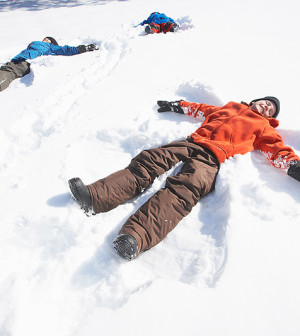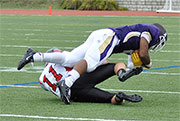- Navigating Your Midlife Crisis: Embracing New Possibilities
- City Raccoons Showing Signs of Domestication
- Mapping the Exposome: Science Broadens Focus to Environmental Disease Triggers
- One Week Less on Social Media Linked to Better Mental Health
- Your Brain Changes in Stages as You Age, Study Finds
- Some Suicide Victims Show No Typical Warning Signs, Study Finds
- ByHeart Formula Faces Lawsuits After Babies Sickened With Botulism
- Switch to Vegan Diet Could Cut Your Greenhouse Gas Emissions in Half
- Regular Bedtime Does Wonders for Blood Pressure
- Dining Alone Could Mean Worse Nutrition for Seniors
School Coaches Often Ill-Equipped to Spot, Manage Concussions


U.S. middle school and high school coaches may not be sufficiently trained and equipped to quickly recognize concussions in student athletes, two new studies suggest.
Without solid concussion training, coaches may mishandle a student’s head injury, experts said.
“High school coaches are the primary responders on the field when head injuries occur, and every state now has some sort of mandate when it comes to the handling of student athlete concussions, which is great,” said Meredith Madden, a resident in athletic training at Boston College and lead author of one of the new studies.
Her survey of Massachusetts coaches revealed some shortcomings.
“What we found is that although high school coaches do generally have an excellent knowledge of signs and symptoms, when they are given management scenarios involving concussion situations that are a little bit atypical, it can become difficult for them to quickly identify the situation,” Madden said.
The other study, involving football coaches in Wisconsin, found some of them also lacked sufficient awareness of concussion guidelines.
Both studies were to be presented at this week’s meeting of the National Athletic Trainers’ Association, in St. Louis. Research presented at meetings is often considered preliminary until published in a peer-reviewed medical journal.
Youth concussion laws vary by state. The good news: In 2009 Washington state enacted the first sport-related concussion laws governing student athletes, and by 2014 all 50 states and the District of Columbia had some type of youth concussion law.
But the National Federation of State High School Associations notes that while most state laws address when to remove an injured player from the field and when to allow an athlete’s return to play, some states — such as Mississippi — do not require high school coaches to take any concussion training.
In states where training is required, Madden said, its effect hasn’t been evaluated. So, she and her colleagues set out to assess the impact of concussion training for high school coach in Massachusetts. There, student coaches working under the aegis of the Massachusetts Interscholastic Athletic Association must take an online concussion-education course within the first year of hire.
The goal is to provide basic first aid instruction and to help coaches recognize signs of head injury or concussion.
Madden’s team conducted an online survey of 104 coaches. Twelve coaches also participated in face-to-face interviews.
Most coaches had basic information on concussion symptoms, the researchers found.
Confusion, headache, dizziness and blurred vision were correctly identified as signs of concussion by more than 90 percent of coaches. Loss of consciousness, nausea and amnesia were also correctly identified as symptoms more than 75 percent of the time.
But only about four in 10 coaches knew that poor sleep is also a symptom, while about 10 percent incorrectly highlighted symptoms that are not concussion-related, the researchers said.
Also, although more than 90 percent of the coaches could properly handle a concussion when presented with a straightforward injury scenario, that number plummeted to less than 60 percent in the face of a less-typical scenario.
The Wisconsin study of more than 700 coaches found that high school coaches were generally well-informed about concussion and related state guidelines, regardless of education level or experience.
But youth and middle school coaches were significantly less able to spot concussions, and the researchers said educational programs are needed for coaches at this younger level.
“We are not saying coaches should have to diagnose or treat concussions,” Madden said. “But we do want them to be able to quickly identify them so treatment happens quickly.”
Steven Broglio, an associate professor and athletic trainer, is also director of the NeuroSport Research Laboratory at the University of Michigan in Ann Arbor. In a perfect world, “all medical decisions need to be taken out of the coaches’ hands,” he said.
“That’s not why they’re there,” Broglio added. “That’s not really what they’ve trained for.”
But, school budgets are often tight, so hiring personnel trained to spot and respond to concussions isn’t always feasible. “In the meantime,” Broglio said, “we do have to improve our education of coaches.”
More information
There’s more on head safety and concussion risk at the U.S. Centers for Disease Control and Prevention.
Source: HealthDay
Copyright © 2025 HealthDay. All rights reserved.










